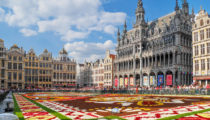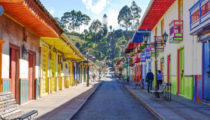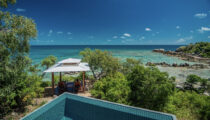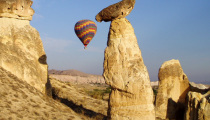November 13, 2009
Tel Aviv’s Top 5 cultural travel experiences
Israel’s most dynamic city, Tel Aviv is the country’s cultural and commercial heart and a highlight of any tour of Israel. Although it possesses no holy sites and a relatively short history (aside from the ancient port of Jaffa), Tel Aviv is a vibrant, 24-hour city with a wide array of cultural offerings, restaurants and nightlife that no other Israeli city matches. Adding to its appeal is a beautiful Mediterranean beach setting. Here is a list of our top five favorite things to see and do in Tel Aviv:
1.) Old Jaffa
This ancient Arab port city, also known as Yafo, was once the gateway to Jerusalem. Archaeologists have unearthed remains dating back to the 20th century B.C., establishing Jaffa as one of the world’s oldest ports. It has since been absorbed into the city of Tel Aviv, and today many of its atmospheric cobblestone alleyways are lined with art studios and galleries. Wandering through the old town with one of our expert local guides, you can see reminders of past and present occupants: old Arab houses, fountains and mosques; Ottoman structures; Greek Orthodox churches, Roman Catholic and Armenian monasteries; synagogues; ancient Roman and Crusader-era remnants; and even a cannon belonging to Napoleon’s army. Browsing Jaffa’s flea market is a highlight. Comprised of shops offering second-hand clothing, intricately patterned backgammon sets, jewelry, Judaica, ceramics and other items, the market also yields the occasional genuine antique for those who persevere. Dotting the market are numerous falafel and pomegranate-juice stands. Or, if you prefer a sit-down meal, join the locals at the perennially popular Dr. Shakshuka restaurant, which specializes in the eponymous egg and tomato sauce dish.
2.) Bauhaus architecture
In 2003, the “White City” of Tel Aviv was designated a UNESCO World Heritage Site for its proliferation of buildings designed in the International Modern architectural style, also known as Bauhaus. The Bauhaus movement started in Germany in the 1920s; German architects who immigrated to Israel introduced the style to Tel Aviv—with a few tweaks to accommodate the climate, such as balconies and smaller windows—and over the next few decades thousands of structures were built in this unique style. Bauhaus-style buildings can be seen throughout the city, but the highest concentration is found on and around elegant, tree-lined Rothschild Boulevard. For travelers keenly interested in architecture, we can arrange in-depth touring with one of our expert architecture guides.
3.) Markets
Tel Aviv is filled with wonderful open-air markets. One of the more popular is Carmel Market—Israel’s largest—which overflows with spices, produce, fresh meat and fish, cheese, clothing, toys and kitchenware. This is a great place to sample delicious baklava and other local specialties while browsing the stalls and listening to the vendors sing about their products. Another great market for gastronomes is the Lewinski Spice Market–this is where local chefs and foodies come to buy exotic spices, olives, dried fruits and nuts, rare condiments and specialty products. Aside from food markets, there are numerous other interesting markets to be found in Tel Aviv, selling everything from rare books, old photographs, antique musical instruments and vintage clothing to Judaica, handmade silver jewelry and folk art and crafts.
4.) Neve Tzedek
Neve Tzedek is the city’s hippest neighborhood, a charming enclave of beautifully restored houses, trendy restaurants, stylish boutiques and art galleries. Founded in 1887, it is the oldest neighborhood in Tel Aviv, and it was home to the cultural and literary elite in the early 20th century. Today Neve Tzedek’s housing prices are some of the highest in the city, yet it preserves the feel of a small village, with its romantic winding alleys and colorful buildings. This is a great area for travelers interested in local art, as there are several first-rate art galleries in the vicinity, as well as a couple of private museums. Several dance companies are also located here, as is the Suzanne Dellal Center, a highly regarded dance and theater complex that is the venue for Israel’s internationally acclaimed Batsheva Dance Company. We often arrange for tickets to evening performances for travelers who are interested in dance or music.
5.) Museums
There are a number of excellent museums located in Tel Aviv that are worth a visit. At the top of our list is the Museum of the Jewish Diaspora, a unique multimedia museum that chronicles various aspects of the Jewish people in Israel and around the world. Using photographs, documentary films, murals, dioramas, audiovisual displays and interactive exhibits, the visitor is taken on a journey across 2,500 years of the Jewish Diaspora. Other good options include the Eretz Israel Museum Complex, which focuses on Israeli archaeology, history and culture; the Tel Aviv Museum of Art, housing works by Israeli and international artists from the 16th century to the present, including especially good collections of Impressionist and modern art; the Helena Rubinstein Pavilion, which holds contemporary art exhibits; as well as other museums dedicated to art, literature, antiquities, military history, and famous figures and events in Israel’s history.
We can incorporate visits to any of these places into our private Israel tours.
Destinations: Israel, Middle East
Tags: Arab, archaeology, architecture, art, Bauhaus, Beit Hatfutsot, best of Tel Aviv, cities, culinary, culture, food, Israel tours, Israeli, Jewish, markets, museums, Neve Tzedek, Old Jaffa, sightseeing, Tel Aviv, Tell Qasile, tourist attractions, tours, tours to Israel, UNESCO

 MENU
MENU


